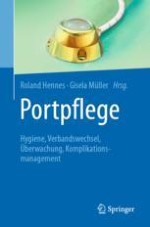Erschienen in:
2020 | OriginalPaper | Buchkapitel
13. Evidenz der Portpflege
Zusammenfassung
Evidenzbasierte Aussagen zur Portpflege sind eine Rarität, die meisten Empfehlungen beruhen auf Empirie. Die wichtigste Maßnahme der Portpflege ist die Einhaltung der Hygienerichtlinien. Für die Punktion dürfen nur geeignete Spezialkanülen verwendet werden. Zur Reduktion des Thrombose- und Infektionsrisikos sollten Blutentnahmen aus dem zentralvenösen Zugang vermieden werden. Vor und nach Flüssigkeitsinfusion oder Injektion sollten Ports gespült werden. Für Art und Menge der Spüllösung gibt es keine Evidenz, in der Regel wird zum Spülen lediglich sterile Kochsalzlösung und zur Blockierung des Ports möglicherweise ebenfalls eine Kochsalzlösung ohne Heparin-Zusatz empfohlen.
Anzeige















